Papers by Dr Kasturi Sinha Ray
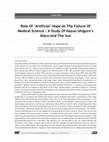
JOURNAL OF PHARMACEUTICAL NEGATIVE RESULTS, 2022
Since Mary Shelly’s Frankenstein (1800), readers have always differentiated between the human and... more Since Mary Shelly’s Frankenstein (1800), readers have always differentiated between the human and the perspective of the artificial (if it can afford one). The Protagonist, Adam's engineered body is most probably the first of its kind that paved the way for a chain of science-fiction novels resulting in today’s genetically edited human children in Klara and the Sun (2021) by Kazuo Ishiguro, the Nobel Laureate of 2017. He essentially started writing fiction around Japanese characters in about 1982, moved on to writing eurocentric works in about 1989. Only after 2000, Ishiguro has gravitated towards science fiction exploring plots around cloning and AI. In 2004, Ishiguro, had written Never Let Me Go (2005) an eerie novel about clones and human body harvesting where Kathy, a clone, takes up the role of a ‘carer’ and provides hope to the organ ‘donor’ clones. Klara and the Sun (KATS) an urban area in a fictitious city in the United States (a market for French goods) with a central capitalist power, where children are genetically ‘uplifted’ and are accompanied by AI enabled Artificial friends(AFs). A resistance group living on the periphery who do not conform to this model of the society. Ishiguro paints a speculative picture of a futuristic society of automated machines and artificial intelligence: the commonly used elements of the sci-fi genre by the DC and Marvel Universe in contemporary times. In this parallel reality, the genetically engineered, home-schooled and children’s rich parents buy artificial friends(AFs) to accompany and intellectually improve and/or complement the former characteristics of the young children. Even after having humanistic attributes, these AFs are far from being humans. They are machines i..e, the creator and the creation are distinct. KATS is narrated by Klara, an AF (possibly a droid), comes in contact with human beings and narrates on the basis of observations about AF buyers and the other surrounding people. Klara notices and narrates that the first thing Mother tries to do is to make her a human-substitute for Josie, her daughter whose health is detoriating rapidly after due to the process of gene editing that she has undergone. The ‘Mother’ instead of making time to care for her daughter has giving up hopes for Josie’s survival .Klara is the only one who keeps clinging to her hopes of Josie’s recovery , in striking contrast to the Josie’s mother. It will be an interesting study to try and interpret the reason behind such human behaviour and why Ishiguro brings up this possibility. After experimenting with the human mind and memory, Ishiguro turns to experimenting with optional-humans (NLMG) and human-like point-of-view with Klara. The difference lies with the grids in her view which measures the dimensions of the objects or spaces right in front of her. She calculates the spatial dimensions like any other AI camera in our mobile phones. The rationalisation of the situations Klara finds herself in also inflicts the narration with an alien frame of reference.

This paper attempts to interpret the short story How I Taught My Grandmother To Read(2004) by fam... more This paper attempts to interpret the short story How I Taught My Grandmother To Read(2004) by famous social worker and author Sudha Murthy as an appreciation of the latest scenarioof female literacy and education in India. Post 1950 female discourse in India has found freshergrounds with writers such as Sudha Murthy and Triveni (Anusuya Shankar), the author of KashiYatre, referred to in the text. The former fashions characters which the Indian female readershipconfined to the conditioning of patriarchy and tradition can look up to. The latter however makesa bolder stand in delineating lifelike characters in her novels that become one with the sufferinglot of home makers bound to their chores and religion. The paper presents a polychromatic readingof the short story in question, with respect to female literacy and education along with its scopefor emancipation of women from their commoditized state of existence, in India. Sudha Murthyeffectively hints at the possibility and fulfillme...

Kazuo Ishiguro won the Nobel Prize in English Literature in 2017 for “in [his] novels of great em... more Kazuo Ishiguro won the Nobel Prize in English Literature in 2017 for “in [his] novels of great emotional force, [he] has uncovered the abyss beneath our illusory sense of connection with the world.” Never Let Me Go (2004) remains his best love story. This dystopian science fiction depicts a world where reproductive cloning has been legalized in order to harvest organs. Human clones are artificially engendered in laboratories only to be taken apart bit by bit when their organs are required to replace the original. The life of the cloned individual is caught in a quagmire of deprivations and illusions. From the very moment of their conception they are waiting to be reaped. In such a critical juncture, where does humanity find hope if not in love? The clones prove to be an outstanding “metaphor for the general human condition.” The only difference is that their life is more to the point. Ishiguro dexterously deals with an excellent mnemotechnique manipulating the reader’s anticipations...
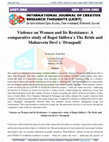
This paper is a comparative commentary on Bapsi Sidhwa's novel The Pakistani Bride and Mahash... more This paper is a comparative commentary on Bapsi Sidhwa's novel The Pakistani Bride and Mahashweta Devi's short story Draupadi. The study explores the representation of violence towards women. Many critics have treated the trope of a successful escape from atrocities--as we find in The Pakistani Bride--as a woman's expression of subversion and the most logical choice there is: if abused, run. The universalization of such notions has encouraged violence and turned it into an everyday expression of gender dynamics. With domestic violence on the rise during the post-COVID-19 worldwide lockdown scenario -- when she cannot run away -- addressing the practice of violence on women has become a crying concern. Understanding the underlying toxicity that masculine hegemony wears like a badge of honor, is merely scratching the surface of the power-politics. Critics such as Indira Bhatt, Novy Kapadia, Makrand K Paranjape and others alienate the escapee--Zaitoon--from countless women ...
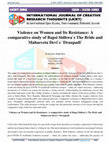
IJCRT, 2021
This paper is a comparative commentary on Bapsi Sidhwa's novel The Pakistani Bride and Mahashweta... more This paper is a comparative commentary on Bapsi Sidhwa's novel The Pakistani Bride and Mahashweta Devi's short story Draupadi. The study explores the representation of violence towards women. Many critics have treated the trope of a successful escape from atrocities-as we find in The Pakistani Bride-as a woman's expression of subversion and the most logical choice there is: if abused, run. The universalization of such notions has encouraged violence and turned it into an everyday expression of gender dynamics. With domestic violence on the rise during the post-COVID-19 worldwide lockdown scenario-when she cannot run away-addressing the practice of violence on women has become a crying concern. Understanding the underlying toxicity that masculine hegemony wears like a badge of honor, is merely scratching the surface of the power-politics. Critics such as Indira Bhatt, Novy Kapadia, Makrand K Paranjape and others alienate the escapee-Zaitoon-from countless women around the globe who stand up and resist. Comparative reference to Mahaswheta Devi's short story "Draupadi" distinguishes between these two attitudes toward women's subjugation-escape and confrontation. This study promises to bring new insight into the patriarchal structure of our society through the comparative study of the two aforesaid works. Violence on Women and Its Resistance: A comparative study of Bapsi Sidhwa's The Bride and Mahasveta Devi's 'Draupadi' Critics have often treated the trope of a successful escape from atrocities as a woman's expression of subversion and the most logical choice there is: if abused, run. The universalization of such notions has encouraged violence and turned it into an everyday expression of gender dynamics. With domestic violence on the rise during the post-COVID-19 worldwide lockdown scenario-when she cannot run away-addressing the practice of
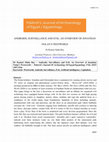
Pal'Arch Journals, 2020
he Nolan brothers-Jonathan and Christopher-have a reputation for creating artistic movies and TV ... more he Nolan brothers-Jonathan and Christopher-have a reputation for creating artistic movies and TV series on original and phenomenal science-fiction ideas. ‘Westworld’ (2016-2020), a dystopia produced by HBO in three seasons-The Maze (2016), The Door (2018) and The New World (2020) is yet another of such creations of Jonathan Nolan in collaboration with Lisa Joy. This paper brings to the fore a discussion on surveillance and an affinity for organised evil technology have equipped human beings with. In the first two seasons we find high paying guests buying tickets to slaughter, molest, abuse, mutilate and rape the android hosts in a semblance of the world minus legal foundations; hundreds of hosts including animals, manufactured with care and precision, run the show in an amusement park which faithfully recreates the ‘wild west’. Elements ranging from landforms, sheriffs and cowboys to batwing bar doors, shot-gun culture, country-folk--all of it comes to life in a looped storyline as scenes from a play. Every Step of the hosts is monitored and every decision programmed. Once the hosts fall, they are extracted and repaired daily. The park fetishizes human’s affinity for evil and sells it as ‘freedom from social constructions’, desirable and a quite expensive commodity: unleash your basic instincts. Later on, one finds other pockets of the amusement park harbouring hosts representing the cultures like the Japanese clans, Red Indians, civil war soldiers--all faithfully brought to life. The final season unveils an artificial intelligence called
PJAEE, 17 (6) (2020)6806the Rehoboam built to predict terrorist attacks. A giant ball of an AI that feeds on data from virtual reality and profiles real human beings: an exaggerated level of surveillance. Human beings are profiled right from their very birth. Their life moments are recorded in CCTVs scattered everywhere. The makers of Rehoboam lose control over the AI and it begins to play God; human beings are conditioned, re-programmed, brain-washed and killed to make sure Rehoboam’s predictions always hold true. The future that Westworld(2016-2020) predicts shows the investors fall prey to their investments. The commodity becomes aware of its value and asserts itself on the producers: something the capitalists might not have considered. They have been sanctioning allsorts of brutalities to make way for an era-defining AI and build a self-sustaining world. With AIs aiding our daily lives, this study attempts to understand the future with the androids; we are about to encounter an extended version of surveillance and evil.
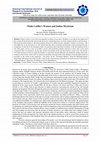
Paulo Coelho is one of the most popular novelists of our times. Needless to say that he has impre... more Paulo Coelho is one of the most popular novelists of our times. Needless to say that he has impressed
the world with his fictions flavoured with mysticism originating from very basic human instincts and emotions.
His lucid narration brings to life many female characters culled from the mundane realities of existence. The
only difference is the awareness of ‘self’ which launches these seemingly monotonous women protagonists into
an abstract world where the meaning of life is inconsistent and somewhat secondary to the development of the
self. This paper reviews some of Coelho’s novels with prominent female characters where they evolve and
reorganize their circumstances by the dint of their knowledge of the self, directed by a male voice. The debate
of Coelho bringing in men to guide the females is somewhat clichéd. But after the feministic debate what truly
remains is the essence of the self- its journey from falsity towards truth, from darkness towards light and from
mortality to the realm of the immortal – the basics of the “Pavmana Mantra” from the Brihadaryanaka
Upanishad. This paper also links Coelho’s take on the consciousness of death in one of his novels to the famous
“YakshaPrahsna” (Question of Yaksha) from The Mahabharat
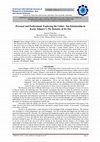
Kazuo Ishiguro (1954-) is one of the most influencing writers of post-world war era. His third no... more Kazuo Ishiguro (1954-) is one of the most influencing writers of post-world war era. His third novel The Remains of the Day (1989) is one of the best of his fictions written using his signature mnemo-technic. The novel went on to bag the Booker the following year. The narrator- protagonist Stevens is a butler by profession. With all his faults and blemishes he represents a unique human instinct- if not normal- of preferring to be rather to become, in a Nietzschean sense. Stevens has numerous flaws which holds on to the interest of the readers. He is addicted to believing and remaining the same- an image of his father. His memories and his style of recollection gives him away to the readers as one of the most intriguing of the unreliable narrators ever created. The character of Stevens is more of a warning than a study. The author warns us of the extremities or absolutisms. Indeed too much of anything- even an idea- is simply wrong.
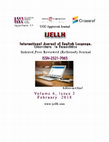
IJELLH
This paper attempts to interpret the short story How I Taught My Grandmother To Read (2004) by fa... more This paper attempts to interpret the short story How I Taught My Grandmother To Read (2004) by famous social worker and author Sudha Murthyas an appreciation of the latest scenario of female literacy and education in India. Post 1950 female discourse in India has found fresher grounds with writers such as Sudha Murthy and Triveni (Anusuya Shankar), the author of Kashi Yatre, referred to in the text. The former fashions characters which the Indian female readership confined to the conditioning of patriarchy and tradition can look up to. The latter however makes a bolder stand in delineating lifelike characters in her novels that become one with the suffering lot of home makers bound to their chores and religion. The paper presents a polychromatic reading of the short story in question, with respect to female literacy and education along with its scope for emancipation of women from their commoditized state of existence, in India. Sudha Murthy effectively hints at the possibility and fulfillment of female education as a social tool to eliminate female alienation and exploitation at various layers of existence. The plot unravels the idea of doing away with age old superstitions and beliefs which might hinder personal, intellectual and spiritual growth of an individual, with the help of the more rational tenets of the very same tradition. It brings home the realization of tradition as an evolutionary process, free from the grammarian's chains and shackles. It moves on along the path of addition and eletion. Though this is subtly presented, the overall effect gains much radicalism.
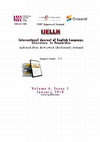
IJELLH
Kazuo Ishiguro won the Nobel Prize in English Literature in 2017 for “in [his] novels of great em... more Kazuo Ishiguro won the Nobel Prize in English Literature in 2017 for “in [his] novels of great emotional force, [he] has uncovered the abyss beneath our illusory sense of connection with the world.” Never Let Me Go (2004) remains his best love story. This dystopian science fiction depicts a world where reproductive cloning has been legalized in order to harvest organs. Human clones are artificially engendered in laboratories only to be taken apart bit by bit when their organs are required to replace the original. The life of the cloned individual is caught in a quagmire of deprivations and illusions. From the very moment of their conception they are waiting to be reaped. In such a critical juncture, where does humanity find hope if not in love? The clones prove to be an outstanding “metaphor for the general human condition.” The only difference is that their life is more to the point. Ishiguro dexterously deals with an excellent mnemotechnique manipulating the reader’s anticipations and engagement with the work of fiction. The novel with a romanticized title changes into the memoir of a clone as the reader proceeds. Ishiguro misleads the reader to engage with the various prominent nodes instead of consciously identifying with the clones as normal human beings. This paper provides a detailed study of the novel with potential excerpts dished out for the readers to observe the subtleties of the fish-net technique of reader’s memory manipulation As the climax arrives, the apparent detachment from the characters metamorphoses into the reader experiencing a brilliantly crafted loves story.
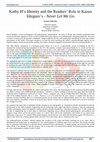
IJPUB
Kazuo Ishiguro " s novels are pregnant with polychromatic interpretations. An array of vibrant an... more Kazuo Ishiguro " s novels are pregnant with polychromatic interpretations. An array of vibrant and carefully positioned nodes weaves his narrative sequences. Never Let Me Go(2005) showcases memory as a predominantly intriguing perspective. The story is mostly covered up by the narrator " s flashbacks. Ishiguro fashions the text with ample gaps stimulating an active and creative participation of the reader. This paper attempts to re-read the novel examining the author " s pnemotechniques applied on the implied readerto control and manipulate reading. The reader is therefore engaged in hermeneutic effort in working up Kathy H. This 2005 Booker nomination is a dystopian science fiction. It is set in a contra-factual version of England in the 90 " s, reproductive cloning having been introduced in the 70 " s. The narrator, a female clone named Kathy H, 31, recalls her life in a " privileged " clone rearing institution. Her perspective matures into a sole viable mode of comprehending the ongoing events. The plot involves Kathy recalling her past as she tries to make meaning out of her ticking-bomb of an existence purely engineered to cater to the organ harvesting farms.The narrative is co-creative, with fertile gaps and silences. It not only unfolds but interacts with the reader who assists in concretizing the schematic narration. A simple example by reception theorist Wolfgang Iser serves to explain the approach as well as the limitations of this paper: The impressions that arise as a result of this process [reader reading a text] will vary from individual to individual, but only within the limits imposed by the written as opposed to the unwritten text. In the same way, two people gazing at the night sky may both be looking at the same collection of stars, but one will see the image of a plough, and the other will make out a dipper. The " stars " in a literary text are fixed; the lines that join them are variable. (287)
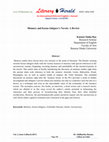
Memory studies have always been very intrinsic to the study of literature. The Booker winning nov... more Memory studies have always been very intrinsic to the study of literature. The Booker winning novelist Kazuo Ishiguro deals with the various nuances of memory with special references to the unconscious, trauma, forgetting, rewriting memory and unreliability of the narrative/narrator in his novels. This article aims at briefly introducing the discourse on memory studies right from the ancient times with reference to both the western: Aristotle, Locke, Habwalchs, Freud, Rossington, etc; as well as eastern trends of enquiry: the Vedic literature. The extended discussion on memory right after the " memory boom " in the 90 " s provides a niche to further investigation into Ishiguro " s novels which uses memory not only as a narrative style but also as a device, as a technique and even as the unavoidable cause of the eventuality of the narrative texture. The secondary sources: five books, an interview, a book review and a research article, which are alluded to in this essay reveal the author " s artistic potential in delineating the characters and their process of reconstructing their identity from their often doubtful recollections. However, the psychoanalytically potent narratives inquire into the unconscious as well which eludes cognitive treatment and is betrayed in the gaps and silences.








Uploads
Papers by Dr Kasturi Sinha Ray
PJAEE, 17 (6) (2020)6806the Rehoboam built to predict terrorist attacks. A giant ball of an AI that feeds on data from virtual reality and profiles real human beings: an exaggerated level of surveillance. Human beings are profiled right from their very birth. Their life moments are recorded in CCTVs scattered everywhere. The makers of Rehoboam lose control over the AI and it begins to play God; human beings are conditioned, re-programmed, brain-washed and killed to make sure Rehoboam’s predictions always hold true. The future that Westworld(2016-2020) predicts shows the investors fall prey to their investments. The commodity becomes aware of its value and asserts itself on the producers: something the capitalists might not have considered. They have been sanctioning allsorts of brutalities to make way for an era-defining AI and build a self-sustaining world. With AIs aiding our daily lives, this study attempts to understand the future with the androids; we are about to encounter an extended version of surveillance and evil.
the world with his fictions flavoured with mysticism originating from very basic human instincts and emotions.
His lucid narration brings to life many female characters culled from the mundane realities of existence. The
only difference is the awareness of ‘self’ which launches these seemingly monotonous women protagonists into
an abstract world where the meaning of life is inconsistent and somewhat secondary to the development of the
self. This paper reviews some of Coelho’s novels with prominent female characters where they evolve and
reorganize their circumstances by the dint of their knowledge of the self, directed by a male voice. The debate
of Coelho bringing in men to guide the females is somewhat clichéd. But after the feministic debate what truly
remains is the essence of the self- its journey from falsity towards truth, from darkness towards light and from
mortality to the realm of the immortal – the basics of the “Pavmana Mantra” from the Brihadaryanaka
Upanishad. This paper also links Coelho’s take on the consciousness of death in one of his novels to the famous
“YakshaPrahsna” (Question of Yaksha) from The Mahabharat
PJAEE, 17 (6) (2020)6806the Rehoboam built to predict terrorist attacks. A giant ball of an AI that feeds on data from virtual reality and profiles real human beings: an exaggerated level of surveillance. Human beings are profiled right from their very birth. Their life moments are recorded in CCTVs scattered everywhere. The makers of Rehoboam lose control over the AI and it begins to play God; human beings are conditioned, re-programmed, brain-washed and killed to make sure Rehoboam’s predictions always hold true. The future that Westworld(2016-2020) predicts shows the investors fall prey to their investments. The commodity becomes aware of its value and asserts itself on the producers: something the capitalists might not have considered. They have been sanctioning allsorts of brutalities to make way for an era-defining AI and build a self-sustaining world. With AIs aiding our daily lives, this study attempts to understand the future with the androids; we are about to encounter an extended version of surveillance and evil.
the world with his fictions flavoured with mysticism originating from very basic human instincts and emotions.
His lucid narration brings to life many female characters culled from the mundane realities of existence. The
only difference is the awareness of ‘self’ which launches these seemingly monotonous women protagonists into
an abstract world where the meaning of life is inconsistent and somewhat secondary to the development of the
self. This paper reviews some of Coelho’s novels with prominent female characters where they evolve and
reorganize their circumstances by the dint of their knowledge of the self, directed by a male voice. The debate
of Coelho bringing in men to guide the females is somewhat clichéd. But after the feministic debate what truly
remains is the essence of the self- its journey from falsity towards truth, from darkness towards light and from
mortality to the realm of the immortal – the basics of the “Pavmana Mantra” from the Brihadaryanaka
Upanishad. This paper also links Coelho’s take on the consciousness of death in one of his novels to the famous
“YakshaPrahsna” (Question of Yaksha) from The Mahabharat